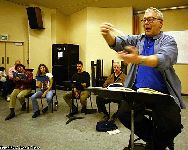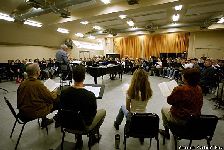George demands, gets a lot
Joshua Kosman, Chronicle Music Critic
Thursday, March 20, 2003
©2003 San Francisco Chronicle | Feedback
URL: http://www.sfgate.com/cgi-bin/article.cgi?file=/chronicle/archive/2003/03/20/DD58062.DTL&type=music
Vance George never thought he'd wind up preparing singers to perform the big choral works of the 19th and 20th centuries -- Beethoven's "Missa Solemnis, " the Verdi Requiem, Britten's "War Requiem."
"I started out interested in Bach, Monteverdi and Schutz," says the San Francisco Symphony Chorus' director with a rueful smile. "The whole idea of doing large-scale works held no interest for me whatsoever."
But since taking over the helm of the chorus 20 years ago, George, 69, has guided his forces through a wide range of repertoire, from the Baroque standards through the most demanding contemporary scores.
A RICH SOUND
And under George's firm, demanding leadership, the ensemble has evolved into one of the nation's top symphony choruses, noted for the richness of its sound and its responsiveness to a broad variety of musical demands.
"This chorus's strongest suit is its flexibility, both stylistically and as far as vocal color is concerned," he says.
"That was my focus at the very beginning -- to make sure that if you're singing Verdi you should sound like an opera singer, and if you're singing Bach you should sound like a Bach singer. That took about five years to cement.
"Now I love coming back from doing guest gigs because I feel I can just walk in and we understand one another. I know what to say to them, and they know how to respond to me. It's very fast."
George professes surprise on learning of his reputation as a no-nonsense worker ("I think I'm the nicest guy around"), but he agrees that he has "definite expectations" of his singers.
"There is health, maintaining the instrument, continuing voice lessons. If your sight-reading isn't good, then work on your sight-reading. Don't be a lazy musician."
Unlike some choral directors, who prepare a chorus in a general way on the assumption that the conductor will make the ultimate artistic decisions, George says he tries to put his stamp on a performance right from the start.
"I basically go through the piece as though I were conducting it myself and give the conductor what I think is a finished product.
"Then if they don't like it, the chorus is tremendously flexible, and they'll change it. But I haven't had any conductors come in who've been really unhappy with what we've given them stylistically."
George began his career as a keyboardist and singer, with a particular interest in the Baroque period; as a 12-year-old, he used the proceeds from his first summer job planting mint to buy a metronome and a copy of Bach's "Two-Part Inventions."
He studied music at Goshen College in northern Indiana and went on to teach at Kent State University in Ohio while he assisted Robert Page with the Cleveland Orchestra Chorus.
TAPPED TO FILL IN
In 1982, Margaret Hillis, the noted leader of the Chicago Symphony Orchestra Chorus, was recruited to take over the San Francisco chorus temporarily after the departure of director Louis Magor. She in turn tapped George to fill in for a few months, which led to a one-year renewable contract.
"It was all very simple; there was nothing dramatic about it. But before you know it, 20 years just creeps up on you. Now, I can't think of another place I'd rather live."
E-mail Joshua Kosman at jkosman@sfchronicle.com.

